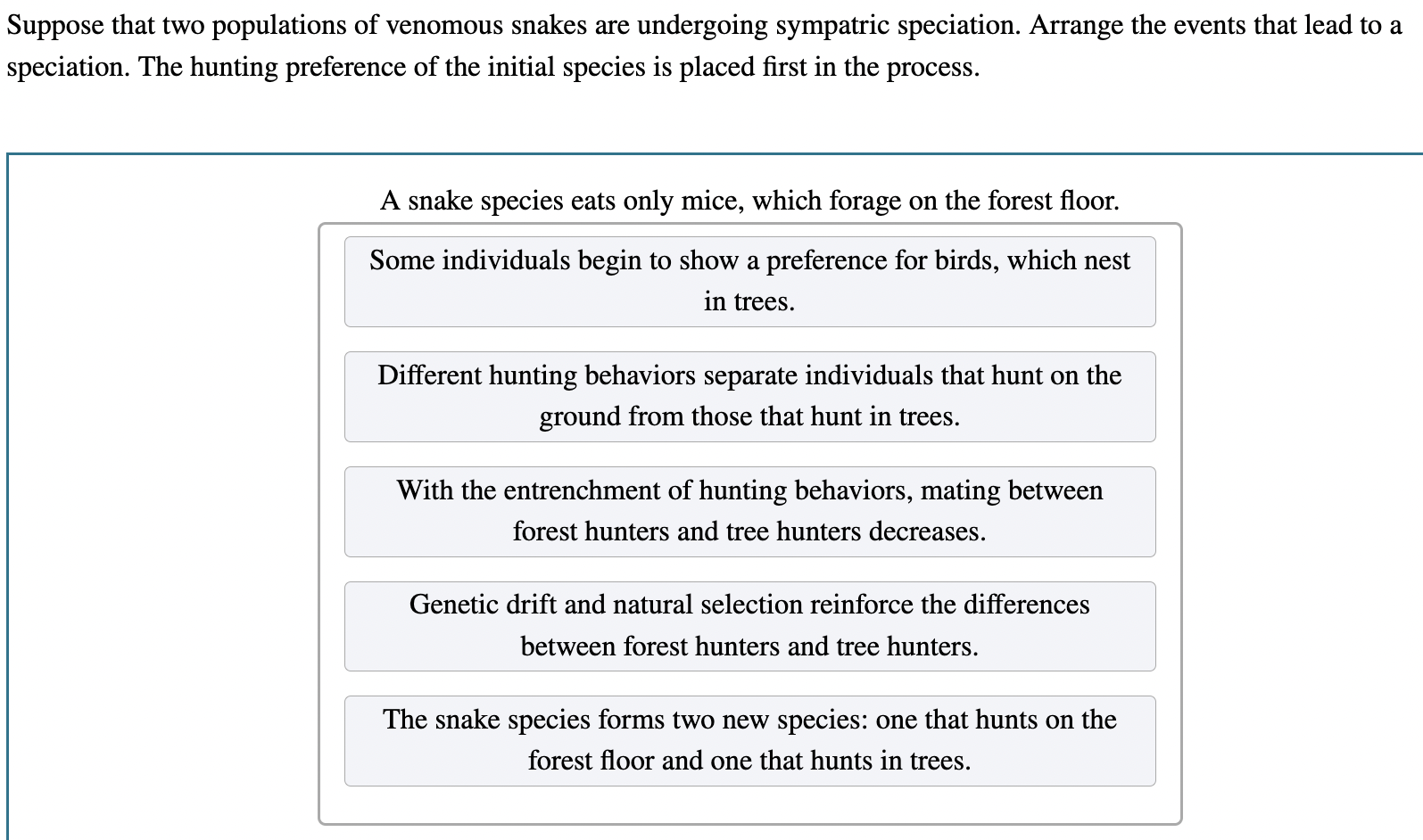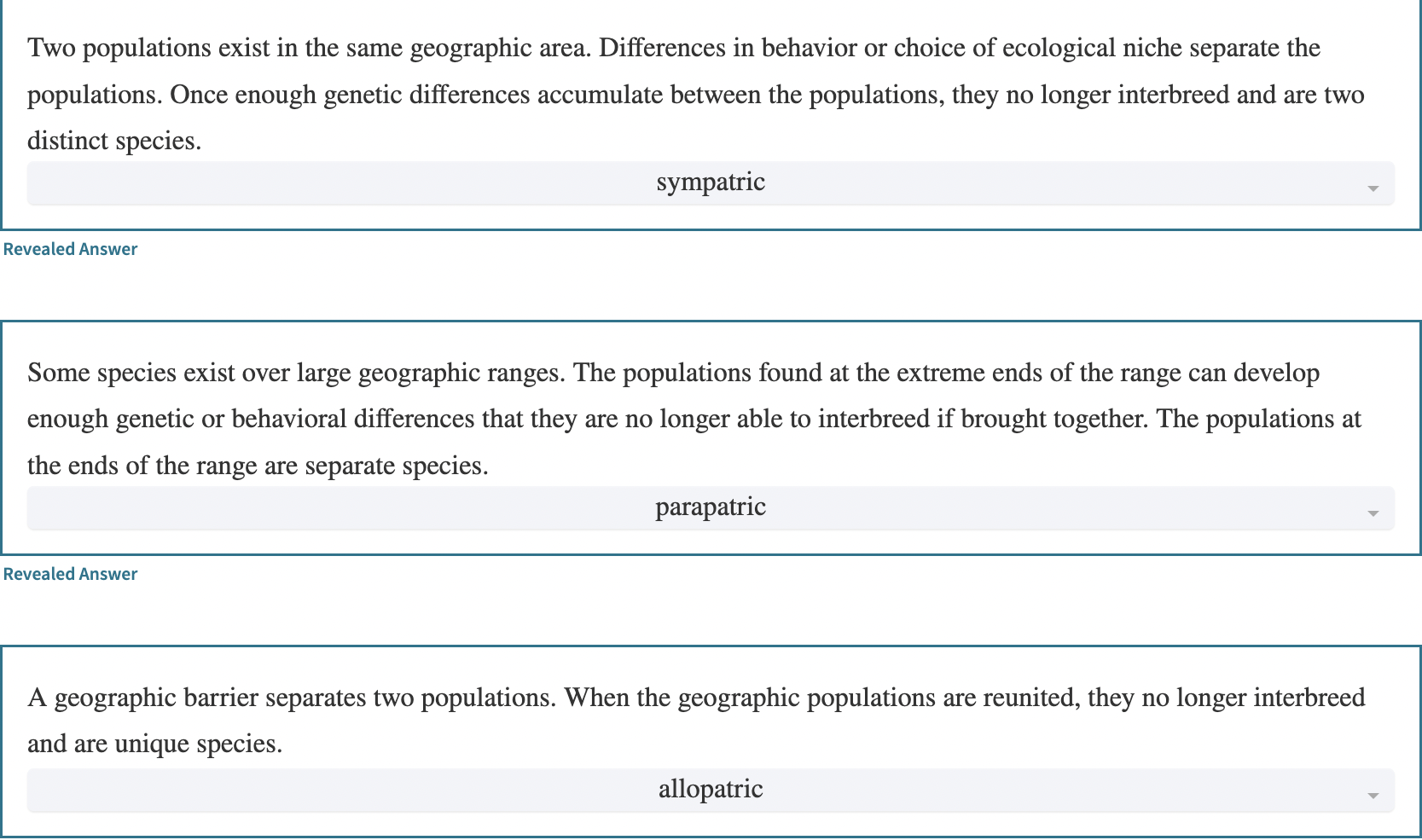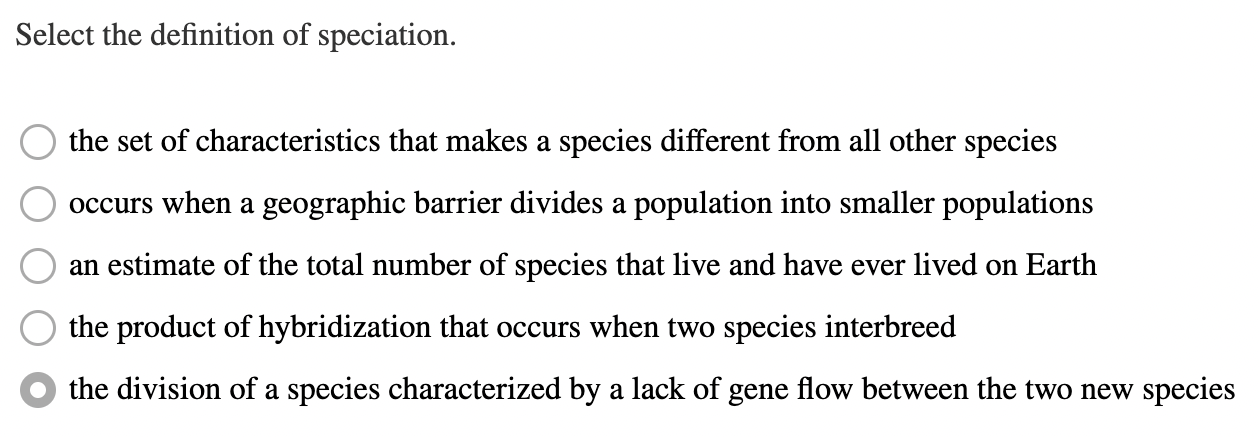BIOB51: Final Exam
Table of Contents
Evolution of Sex (Lecture 17/18, Ch. 11)
Life History & Parental Care (Lecture 19, Ch. 12)
Origin of Species (Lecture 20/21, Ch. 13)
Macroevolution (Lecture 22, Ch. 14)
Coevolution (Lecture 23, Ch. 15)
Brain & Behaviour (Lecture 24, Ch. 16)
Evolution of Sex
Papua New Guinea - Bunch of birds, Darwin had many questions about why there are so many different traits. A great example of sex evolving so weirdly.
Types of Sex
Asexual species: all members are the same sex, producing two offspring and do not need to encounter any other individual to do this. Population grows quickly, in the best case scenario it is doubling with each generation.
Sexual species: Need a mate to reproduce, half of the offspring will be male, only producing 50% of amount of females.
Rate of reproduction in sexual species is half of that compared with asexual. Asexual species should be more abundant if offspring production same for sexual and asexual. Offspring from both have equal fitness.
Why are there so many sexually reproducing species
Muller’s ratchet: Genomes of asexual populations accumulate irreversible, deleterious mutations over generations. Can only turn in one direction.
Genetic load: burden of accumulated deleterious mutations over time.
Deleterious alleles become fixed in asexual populations but are purged from sexual populations.
Red Queen effect: makes sex beneficial. Host has advantage, i.e. better survival. Red Queen runs so fast to stay in one place, working at optimum speed to keep others at bay, no progress, otherwise it will be problematic.
Snails: 66% of the population of sexual and asexual are asexual females. There is variation with different frequency of parasitism, intensity of infection correlates with frequency of males. Sexual populations have an advantage to fight off parasitism or something.
Reason for exaggerated traits that seemingly decrease survival: They are able to make stronger babies, because they can survive with such an adversary.
Darwin’s Dilemma
Differential parental investment
Egg and sperm have a massive disparity in size, a lot more energy is put into the egg than each individual sperm. Kiwi bird egg is 2/3 mass of the bird itself and takes a ton of maternal investment.
Females are limited by fecundity and males are limited by number of mates typically. Females also have certain paternity, while males deal with uncertain paternity.
Parental care/investment of resources could be directed to an offspring that isn’t even their own.
Differences in motivation, ultimately about maximizing output, which differs for males and females.
If sexual reproduction has different pressures on males and females, then males and females may have different strategies for maximizing their lifetime reproductive success (fitness).
Operational sex ratio (OSR): ratio of males to females capable of reproducing at a given time. Slower rate of reproduction by females leads to male-biased OSR (females are limiting with male-biased OSR)
Puzzling patterns
Sexual Dimorphisms result from sexual selection, situation where male and female look different from each other.
Ornaments: attractive traits that increase mating success (intersexual)
Armaments: weaponry used to outcompete other individuals (intrasexual)
Types of sexual selection
Intrasexual (competition): within your species, fighting over mates.
Intersexual (mate choice, attractiveness): between, males and females competing with each other for the affection of the other.
Sexual selection is commonly stronger on males, with male biased OSR. Selection favours males that outcompete other males for access to females.
Elephant seals (intense sexual selection): Number of offspring females have in a lifetime may be small, while many males are either 0 or 100 or some crazy shit. Major disparity in strength of sexual selection, huge gap in male sexual selection compared to females. Only way to mate is by winning a fight, occupy, impregnate, get kicked out by another male and go search. Harems.
Why be choosy?
Competing for mates is costly. For many males, after their peak of sexual maturity (9), their survival drastically tapers off. Peacocks have a very high variation of reproductive sex, while females have very low variation.
Benefits of female choice:
Direct benefits: benefit the female directly. For example, food, nest sites, protection
Indirect benefits: benefits that affect the genetic quality of the female’s offspring
Darryl: 2 different species of cricket and grasshopper. Female is holding what the male gave to her, and it stays on females abdomen, pumping sperm into her, or they might give a food gift. Larger egg will give larger offspring typically.
Female being choosy for best spermatophore increases size of eggs and amount you can lay.
Female red back spider (Andrade): her mate is getting eaten. Sperm brought from pretty pale, inserts in female, males can only make it twice, and then becomes the ultimate gift to females. It lays on her fangs.
A female mating with attractive males produces attractive sons and daughters that want to mate with other attractive sons and daughters.
Females should be choosy about mates because of anisogamy, offspring care, while the opposite is true for males.
Alleles that increase male attractiveness or ability to compete should increase in population via sexual selection. Works more strongly on males than on females.
Trinidadian guppies: males vary in colouration, orange females are most interested in. They painted pennies and females pecked far more orange, coinciding with preference for orange men. The preference of colour came before preference in females.
Phylogeny in species: female mullies prefer a swordtail male.
Ornaments: swordtail is prefered before they even evolved. Quality of potential mate. Artificially lengthened is most favoured. Tail cut and replace and normal unmanipulated tail is the same.
Long tails are difficult to maintain, an honest indicator of male quality.
Resource allocation: developing weapons can involve trade-offs
How they allocate their resources and how they develop these weapons. The development of other features on the selective lines of genes, 0 means no difference between them. Hugely significant eyes. Shorter horns, larger eyes. Short horns worse at fighting but you can see better.
Roles reversed when factors reversed
Mutual courtship behaviour: mutual because input of sexes is the same. No disparity (males and females choose each other).
Male dance fly that has capture a fly gather in open fields to mate. Male dance flies are choosy, females are showy.
The more variation in females, we get a role reversal. Who is showy as their sex traits have the most variation in reproductive sex usually.
Mating Systems
Monogamy: one male and one female pair together.
Sexual: partners mate with each other exclusively
Social: partners pair but may cheat
Polygamy: multiple partners
Polygyny: males mate with multiple female (females only mate with single males)
Polyandry: females mate with multiple males.
Sperm competition: sperm from multiple males compete to fertilize the egg, internally competitive. Males (or their sperm) utilize several strategies to increase fertilization success.
Polyandry selects for male traits, increases paternity rates.
Penis of male aedeagus. Inserts and scrubs out sperm of previous male, increase chance of paternity. Longer spines means more fertility. Damages female internally and can kill her. Squirrel penis bone looks like a shovel and scoops pulling out sperm from past mates.
Penis bone of an extinct walrus is long and is actually a bone. Humans one of the only species where the penis does not include an actual bone.
Pre-chicken domestication: females are storing sperm, can somehow tell if it is from something related to them or not related to them
Cryptic female choice (red junglefowl): Females store sperm following insemination, more sperm from unrelated mates than related mates. Some feral populations of domesticated fowl - females can forcibly eject ejaculates following insemination.
They pick the least related male partner to avoid inbreeding
Assessment happens during the mating process, puts sperm in pocket and will pick out the least related.
Sexual conflict: interests of males are “at odds” with the interest of females. Traits conferring fitness benefit to one sex but a cost to the other. Antagonistic coevolution of traits, often cyclic (recall host-parasite Red Queen)
Argentine lake duck: explosive penis. Genital morphology changed by forced copulations. Straight simple reproductive tract, the length and shape of penis of species - no forced copulation. Corkscrewed reproductive tract - female reduced insemination, so males evolved penises to corkscrew inside them as well.
Female genitalia gets more complex, as does the male. Driven by differences in interest and modes to achieve highest fitness.
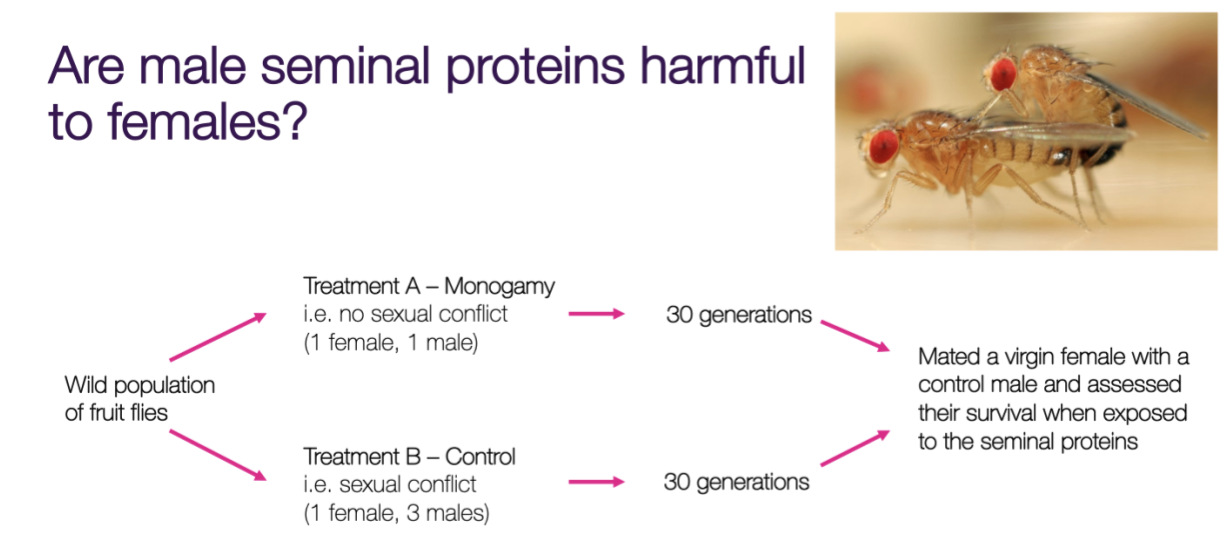 Males transfer seminal proteins. Triggering physiological behaviour of females to get ready, but it is toxic. Stops them from having sex with others, females naturally mate with other males. Monogamy is non-natural (pestered less), while polygamy is the control (constantly mating), put control and monogamy in a group and what happened.
Males transfer seminal proteins. Triggering physiological behaviour of females to get ready, but it is toxic. Stops them from having sex with others, females naturally mate with other males. Monogamy is non-natural (pestered less), while polygamy is the control (constantly mating), put control and monogamy in a group and what happened.
Females survival dropped in a monogamous group, while selection did not require them to remain in their groups for many generations. No longer had those dukes up to get rid of toxic stuff.
Males do forced copulation with females, means the female likely has issues with reproduction.
Mating is costly: water bugs have to deal with back swimmers. When it comes across an organism to grab, it grabs and mating makes it so that the female cannot get away. Females are harassed by inadequate mates. Mating is costly so they avoid unnecessary copulation. Males just mate as often as possible with many females.
Gripping spikes develop
Distal-less (Dll): important for legs and mouth and antenna. If changes in distal-less expressions can change stuff.
RNA interference - RNAi: effective way to experimentally decrease gene expression. Dll dsRNA was injected into nymphal male water striders. Selectively binds to correlated RNA, causing RNA to degrade and shut down before protein made. They can stop the development of the antenna.
Varying degrees of Dll expression have varying. Normal, mild reduction and moderate reduction each have a drop in male advantage
Life History and Parental Care
Traits:
Age at first reproduction
Duration and schedule of reproduction
Number and size of offspring
Reproductive effort
Life span
Life history strategies are subject to evolutionary forces.
Life history: strategies for reproducing, growing, and surviving that an organism uses during its life.
The bristle tree lives for about 4000 years and reproduces their entire life. Mustard plants reproduce once and dies. Coral is asexual, immortal, collection → can be frozen and reanimated when lake dries up.
Involves trade-offs: limited energy to invest in survival, maintenance, and reproduction. Selection optimizes trade-offs like maximizing number of offspring surviving to maturity, depends on likelihood of survival to different age classes.
Off the coast of Georgia, there is land that used to exist there. As sea level rose, sapelo island was isolated. Comparison between the islands because the predators did not make it to Sapelo Island. Age and survival extremely limited on mainland Georgia. 18 months old these Opossums have arthritis and cataracts.
Increase in longevity on the island. More are surviving on the island. All dead by two years of age compared to some living close to 4 years. Island not allocating much to offspring, fewer offspring because most are going to survive, deteriorating less.
David Reznick
Water pools from waterfall, pools differ in amount and type of predators inside of them. Predation pressure and life history traits amongst guppies.
Kili fish - Rivulus Harti, can only kill the small babies, while spike (large) goes after the young and the adults.
Guppies at the bottom are from live birth, using more of female’s resources.
Predation risk drives life history evolution


Observational experiment - 11 years study. Keep removing predators /relaxing predation. Experimental evidence agreeing with their observational evidence
Ryan Cowslick and Brian Cough:
Is there a tradeoff between growth and reproduction. Opened up female and did a surgery. Ovaries removed or things were moved around. Prevented reproduction, they grow to a heavier mass and survive longer years with the inability to reproduce. Allocating resources comes at a cost of growth and survival.
Parental Investment
Females are more likely to provide - parental care
Males invest less in reproduction, and have uncertain paternity. Some show role-reversal.
Operational sex ratio (OSR)
Sexual selection, members of one sex compete for matings
Theory from 1970s: Robert Trivers. When we talk about investment we are talking about the parenting. Sperm is cheap and plentiful, involved less. OSR is very important - proportion of any given sex available to mate at any given time.
Pipefish (Adam Jones): related to seahorses. Brood pouch, females make the egg and fertilize and transfer to male to carry. Males have fewer mates, males mate much quicker with larger females transfer more eggs and produce more viable offspring. Increase number of offspring.
Organisms may regulate OSR - miscarriage, cannibalism. Organism may regulate to maximize fitness.
Meiotic drive: produce more of one sex than another.
Female-female competition. Investment are risky, some animals develop flexible strategies to different challenges.
Many animal embryos miscarriage more likely when their offspring have extra copies of chromosomes. Spontaneous abortion.
Sand Gobies
Male sand gobies - have a little clay pot, male guards and covers the eggs with sand, removes algae that may grow on it. When oxygen levels are low, high and low densities die, while with high oxygen and low density of offspring live a lot longer (high density will still use up the oxygen). Males go in and eat the eggs. Decrease density of offspring to increase chance of survival of remaining eggs. Offspring survival increase happens in mostly low oxygen positions. By selectively eating some of the eggs, fathers may improve the chances that the remaining eggs will survive.
Triver-Willard hypothesis:
Polygynous: one male and many females. Relies on mother to asses her own condition.
Mother alters sex ratio depending on their condition. Produce females when in poor condition. Daughters likely have offspring, even in poor condition.
Produce males when in good condition. Males benefit more from being large & will more readily attract mates.
Sex ratio
Seychelles warblers
High resources: females favoured, up to three helping daughters is beneficial (88% daughter)
Low resources: males favoured, disperse away from poor habitat. (23% daughter)
Red junglefowl: opportunities to ‘alter’ sex ratio: Can lay an egg once a day. Calcium layer is put on an hour before laying. Selectively reabsorb eggs from one way or another, cryptically choosing. When egg comes down the line, one passes through and one is dumped
Parental conflict
Eurasian penduline tit: Nest is an extended phenotype, how females choose males (males sing around their nest). Enlarge nest and one will choose to incubate. One third of the nests are abandoned and the eggs are just sitting there - why might you abandon.
Increase reproductive success. If male leaves too soon, female may leave and find a new man, waste of a nest. Stays too long may have to be stuck incubating 3-4 eggs. Female wants to lay all eggs.
Male and female are watching each other, are they still laying eggs. Females have started hiding their eggs, and then takes off and male will be stuck with the eggs, so they all watch each other.
Parent-offspring conflict: Parent and offspring disagree w.r.t. investment. Optimal allocation of parental investment differs depending on perspective. What is most beneficial to mom is not most beneficial to offspring. Disagree with what to invest in. Mother withholding energy so she can allocate them later to other kids. Bird babies have ornamented mouth, parents are attracted to the mouth and the sound.
Red food colouring is really high. The more red the more change at obtaining resources from the mom. Begging and red, gets the food. Birds yelling do better if their beak is dyed red.
Sibling rivalry: Fulica americana, babies are brightly coloured. All orange and all black, exactly same amount of feeding. When he had some orange and some all black they much preferred the orange.
Genomic imprinting
Epigenetic effect, parent-of-origin effect, methylation.
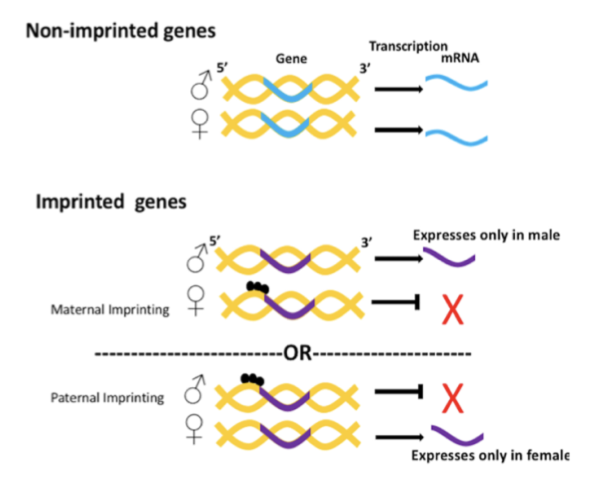
The growth of mammal embryos is controlled by a network of promoting and inhibiting genes. By silencing a growth-promoting gene, a mother can rein the growth of an embryo. By silencing an inhibiting gene, a father can promote it. In one experiment, silencing maternal growth-inhibit gene makes them grow larger than normal. Father’s growth promoter gene being kicked out made mice born smaller.
Postponing senescence
Senescence: deterioration with age. Caloric restriction can slow down the aging process. Genes involved in repair switched on under stress. May involve trade-offs. C. elegans mutants that age more slowly have lower fitness.
Restricting diet may active cells that repair damage cause by not-eating stress. P53 tumour suppressor is a good life saving mechanism similar to the not eating stress response.
Effective stopgap defense, kills cancer but also damages the body in the process.
Age at last live birth and age at death are positively correlated.
Mother hypothesis: reproduction late in life is risky. Invest in current offspring.
Grandmother hypothesis: loss of fertility associated → shift investment towards grandchildren. Maintain strength (by not reproducing) to assist with grandchildren.
Reason for menopause.
Killer whales and fin whales are the same. Groups stick together for decades. They lead packs too afterwards.
Origin of Species
Species: smallest independently evolving unit. Follow independent evolutionary trajectories. Defining species is contentious. 22 different theories about how to define what a species is exists. What is a species is a man made concept, problem with lines being poorly defined. Species is the tips of branches and we’re still sorting them out today.
It doesn’t matter, but it messes with our desire to compartmentalize. Are they the same or are they different, who cares.
We have certain resources available or unavailable with extinct species (can’t hybridize), most common morphological variation. Slight difference in length of femur could be the difference of a species. We can use behaviour and where species are found as information. Lines become blurred with abundant overlap.
Extant: more than morphology (behaviour, geography, dispersal tendencies). Luxury and curse. Lines are less distinct, with abundant overlap.
Species concepts
Phylogenetic species concept (PSC): smallest possible group descending from a common ancestor; recognizable by unique, derived traits.
Useful for systematics. Focuses on phylogenetic history.
Biological species concept (BSC): species are groups of potentially interbreeding populations that are reproductively isolated from other such groups
works well with sexually reproducing animals and is the most common species concept.
General lineage species concept (GLSC): species are metapopulations of organisms that evolve independently from other metapopulations.
Metapopulation: group of spatially separated populations of the same species that interact at some level. Significant gene flow between metapopulations = same gene pool.
Researchers continuously refine species definitions
Barriers
Lots of gene flow between lineages can cause a barrier. Drought, river, mountain ranges, genetic differences all stop the ability to mate through gene flow. If enough differences accumulate, they may differ morphologically, may remain still reproductively similar or not, does not always lead to speciation.
Geographic barriers: extrinsic properties of landscape that prevent gene flow → alloparty.
Reproductive barriers: features of organisms that prevent interbreeding. Barriers effective even in sympatry.
Boulder star coral species complex → one species that will eventually become two species. They flow to areas and new coral starts to grow. Release of gametes.
Reproductive barriers
Premating barriers
Timing of reproduction: Look very similar, the only small change between species is when they release gametes. Spawning times do not overlap, so we avoid hybridization. Allochronic speciation - reproducing at different times.
Pollinator isolation: Monkey flowers. Lewisii and cardinals can hybridize, and the two hybrids get many different variations. They are capable of hybridizing, but they issue is with the landing spot or open tube for the hummingbird.
So few hybrids because of the pollinator issue and where flowers are found. Lewisii is found at higher elevation in mountain ranges, and the overlapping mainly highlights the issue with pollinators. 0.6 elevation issue, 0.4 pollinator issue.
Mimulus lewisii → bee pollinated, at higher elevations
Mimulus cardinalis → hummingbird pollinated, lower elevations
Postmating, prezygotic barriers
Physical damage: hybridization results in damage to female reproductive tract. Beetle where male mates with wrong species stops females from being able to reproduce.
Gametic incompatibility: sperm or pollen fails to penetrate and fertilize other species. Louisiana irises → female stigma has pollen grains fall on top. Pollen grains of non-species stop moving through, while same species gets through. Due to alternate pollen, species are unable to pollinate. Postmating, prezygotic.
Postzygotic barriers
Hybrids are produced but have low fitness. Hybrid inviability, hybrid sterility, ecological inviability, behavioural sterility. Ring-necked dove and rock dove cannot create good offspring.
May lay eggs, but only 6% hatch. Ecological means they have issues in their environment.
Genetic basis of postzygotic isolation: You have ancestors on two different loci but only 1 allele, and as they diverge, new alleles arise and become a different version. Hybrids will be heterozygous.
Epistatic interactions: things at 1 locus affects things at two locus
Bateson-Dobzhansky Muller incompatibility (B-D-M)
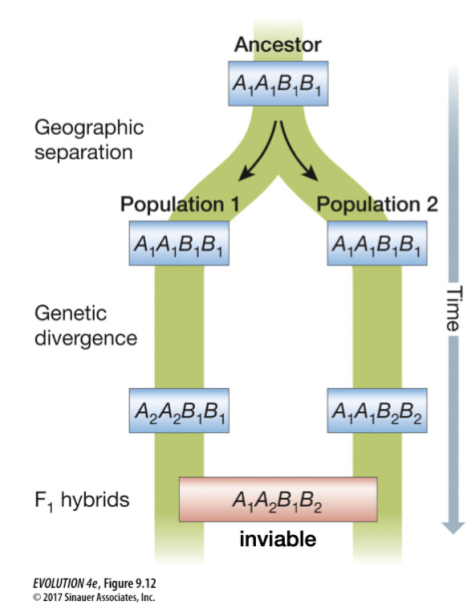
B-D-M incompatibility in monkeyflowers: 2 loci by QTL analysis (chromosome 6 & 13). Only looking at hybrids, homozygous have much lower compatibility, if your hybrid is homozygous it dies. Invisibility at different loci.
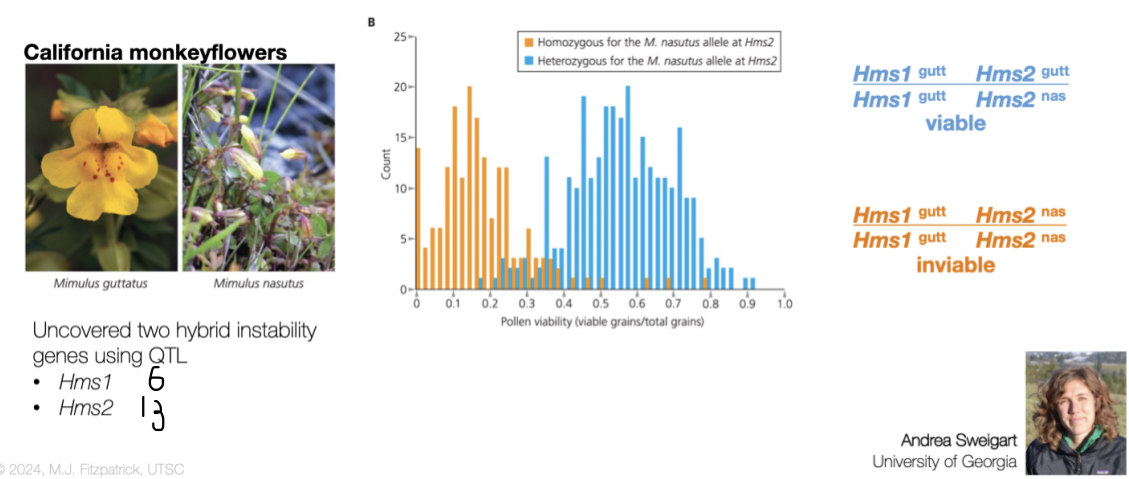 B-D-M incompatibility in swordfish: there is a little dot on birchmanni and none on malinche. The little dot is important because hybrids produce an extreme amount of melanin.
B-D-M incompatibility in swordfish: there is a little dot on birchmanni and none on malinche. The little dot is important because hybrids produce an extreme amount of melanin.
Melanoma: cancer cells. The loci of birchmanni has the ability to suppress tumour growth which malinch doesn’t. The hybrid will have and spot and tumour suppressor sometimes, but often they don’t have one and will be more likely to get cancer.
Reproductive isolating barriers

Allopatric speciation
Differences formed through space
Single population (with variation → river splits population (different conditions) → population stats adapting to conditions → river dries up (left and right side intermingle and no longer intermating)
Vicariance: the physical splitting of a habitat (like above)
chance separation
genetic drift and selection
two populations are isolated
Dispersal: population moves to new habitat, colonizes and finds new population (darwin’s finches originally dispersed from Ecuador to inhabit Galapagos Islands)
Dispersal and colonization
Genetic drift and selection
Two populations are isolated
Islands provide opportunity for allopatry through colonization. Populations on same islands often differ in male song and female preference for songs. Crickets in Hawaii (Shaw). Crickets colonized different island and 2 species on the same island even looked different. She studied what makes them different. How fast he is producing, females prefer their own species song. It’s very obvious who they care about in terms of linkage disequilibrium. Male song and female preference go hand in hand.
Reinforcement
Selection favours prezygotic isolation mechanisms preventing formation of hybrids with reduced fitness. Postzygotic isolation must evolve in allopatry.
Reinforcement mechanisms: mechanisms that reinforce the divergence that has already begun. Premating, means of preventing hybridization. Often occurs through reproductive character displacement.
Field crickets: texas field cricket (texenis and rubens). Texenis lives closer to texas, while rubens is in Florida. They overlap in an area (return to sympatry), there is a lot of overlap. The male song. Allopatric separation and divergence, when they return the songs overlap considerably with high potential of hybridization. The species song gets a lot different to reinforce difference and females preference follows the switch.
Sympatric speciation
Formosa: flowers hang down (pendant), and are pollinated by hummingbirds.
Pubescens: flowers are upright, and are pollinated by hawkmoths.
The two flowers are from the same genus, but underwent speciation due to pollinator preference and more drastic ones were chosen.
Palm trees are similar to volcanic Hawaiian islands to find them on their own. Kentia and curly differ in the soil they can live in. Kentia needs volcanic basalt soil, while curly palm needs calcareous soil.
New type of soil: water levels lower and a soil that was full of marine life, and soil is volcanic and has so many nutrients. Area allows a new species to emerge. Despite curly (old) living so close to kentia (new), they are not crossbreeding. This is because they reproduce at different times. Similar to corals. Very little area of overlap. Between 5 and 6 is only reasonable interbreeding time.
Parapatric speciation
Neighbouring populations diverge while still exchanging alleles. Neighbouring populations diverge but still exchange alleles.
Cline: gradient of conditions (pH of soil, temperature, etc)
There will still be a hybridization zone, until we get to speciation.
Lizards: adaptations in lizards by sand. Changes in head shape, toe length, and colour. Reality showed us that a lot more gene exchange happens than we would assume of sympatric speciation, meaning there is still a very relevant hybrid zone phase, maybe even a cline.
Ecological speciation
Reproductive barriers from because of selection for different ecological traits in different niches. Can lead to pre and postzygotic isolation.
Ecological niche: role species play in its environment. Habitat requirements, nutritional needs, water needs.
Grizzly bears and polar bears look very similar. During the ice age, some grizzly bears were isolated in Greenland and needed to adapt to a new cold environment. General lineage of Grizzly bears shows that a split so long ago. As isolation on Greenland stopped, there began to be less and they were capable of interbreeding.
Genes under strong selection in polar bears is linked to ecological niches.
APOB protein bind cholesterol. Heart function depends on diet and swimming. Hair pigmentation.
Allopolyploidy: can lead to rapid speciation. Adapting to local ecology. Different numbers of chromosomes form together and should be impossible. Embryo is fertilized and would normally just die, but before it dos, there is a spontaneous duplication of all the genomes. Then two gametes create a diploid. Two species that can’t hybridize, create something completely new and can no longer mate with either original species.
Speciation in plants can be rapid due to allopolyploidy
Isolation takes millions of years in birds and mammals
Two species with same amount of chromosomes can also see spontaneous doubling. There was no need for time to lead to divergence, it literally happened instantly and was believed to be similar of humans. Fusion of two chimpanzee chromosomes created a human chromosome.
Allopolyploidy: when two different species come together and from a haploid gamete with a messed up arrangement of chromosomes. Polyploidy resulting from interspecific hybridization.
Cryptic species
Sometimes speciation is happening but it is not obvious
Neotropical butterflies are a direct tie to a specific flower. Extremely restrictive diet. Feeding is different, and adults look the same, but the caterpillars themselves are completely different. They don’t need to change, because butterfield don’t care about mating.
Barcoding: cytochrome C section barcodes a species
The Astraptes fulgerator is actually 10 different species through cryptic speciation. It is cryptic to us, not the organism. Important to measure cryptic species so we can measure biodiversity.
Microbial species
Fission recreation is a puzzle. Different microbial species can communicate through projection, which creates convolute for gene transfer, or to ingest.
Horizontal gene transfer: Sequenced genome of strains of E. Coli. Elements that were similar to all three strains are highlighted in a venn diagram. Pan-genome is a highlight of all genomes under the 3 species. They sequenced 3000 bacterial genome, a core genome across all different strains showed about 3200 genes which were important in all. Transfer of alleles across phylogenetic trees, happens in asexual populations
Pan genome - 90 000 genes.
Horizontal gene transfer overcomplicates classification. If they are sharing, the genomes are not well defined in area of genetic exchange, and is difficult to classify each species.
Horizontal gene transfer is common. If we look at a phylogenetic tree, it is rather well defined until we overlay the effect of horizontal gene transfer between species. There is no answer on the species concept issue.
What defines a species? The core genome is a good place to start, while the rest is pan genome.
New species concepts in microbiology may provide valuable insight into the evolutionary history of disease-causing organisms.
Macroevolution
Microevolution: evolution occuring within populations. Adaptive and neutral changes in allele frequencies.
Macroevolution: evolution above the species level. Origination, diversification, and extinction of species over time.
There are 1.5 million beetles, new species evolve faster than old ones go extinct. We’ve only characterized like 300 000 species. 3 explosions in our time period.
Explosions: lineages shifted to feeding on angiosperms (conifers → cycad → angiosperm)
A few different plants were eaten from and then the plant world adapted like crazy and beetles shifted to feeding on flowers. Triangles on graph show flowers eaten (too many to look at individually)
Species diversity
The greatest amount of species diversification occurs in the trops. Extremely high levels of biodiversity and endemic species. One tree in the amazon can house 43 different ant species, same as all of Britain.
Biogeography: calling of Wallace. Study of species distribution across space and time. Nearly all marsupials are in Australia.
Wallace’s line: not a huge geographic distance, the species North and South of the line do not interact. Deep trench, non-geographic barrier keeping them apart. Between Criental and Australia.
A northeast kangaroo - population represents descendants of those recently brought by humans
Species diversification patters
Dispersal: movement of populations from one region to another with limited or no return exchange
Vicariance: formation of geographic barriers to dispersal that divide a once-continuous population
As Hawaiian islands formed, this was the original and moved its way out due to tectonic plates.
Phylogenetic signature: continent splits in 2, diverging again, 4 new species, a tree would connect by vicariance event 1 showing them collectively diverging.
Marsupials: three kids on the go at once. Weaning, embryo, pouch. Come from a clade from few marsupials in South America.
Pattern of geography: first pattern based on continental drift, second is based on different characters, there is strong congruence. Original marsupials developed in China, moved across Asia and Europe to N America, and some went back to Asia, or Africa, Antarctica, S America. Species of marsupials in N America, Europe and Asia died off. Only N American marsupials are ones moved up from S America (opossum in Georgia)
Rate of extinction and origination
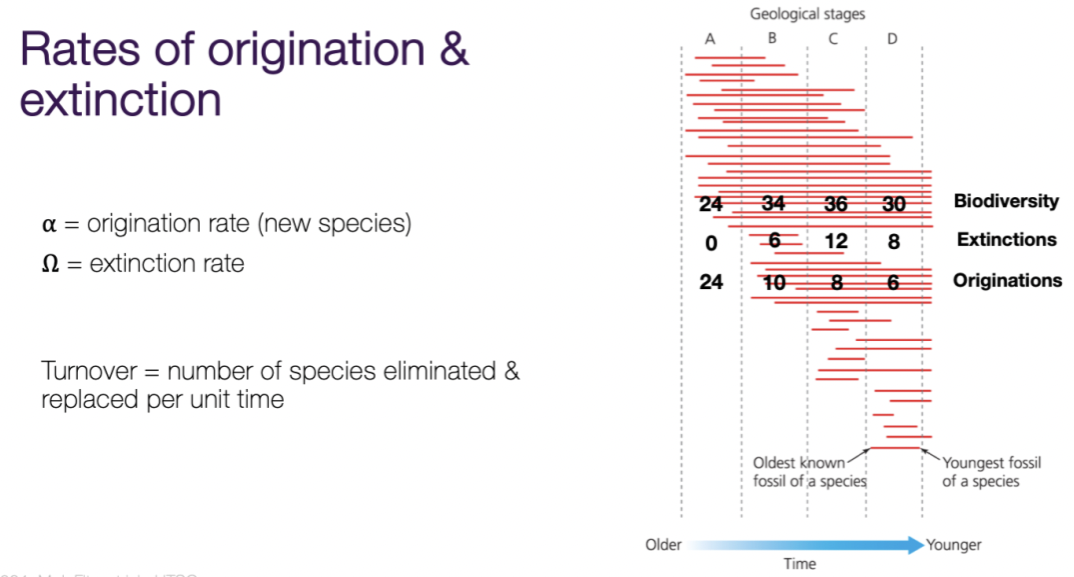 Understanding patterns of biodiversity. Biodiversity is the total amount of species found during the time period. Different rates of change over time.
Understanding patterns of biodiversity. Biodiversity is the total amount of species found during the time period. Different rates of change over time.
Scientists use the rates of origination and extinction of species in the fossil record to examine the history of life on Earth. Origination occurs when fossil record indicates a lineage split into distinct clades. An extinction occurs when the last member of a clade dies.
Evolutionary faunas
Animals of a particular region, habitat or geological period. Stars mark peak diversity of an era. Currently more species of modern species than ever before
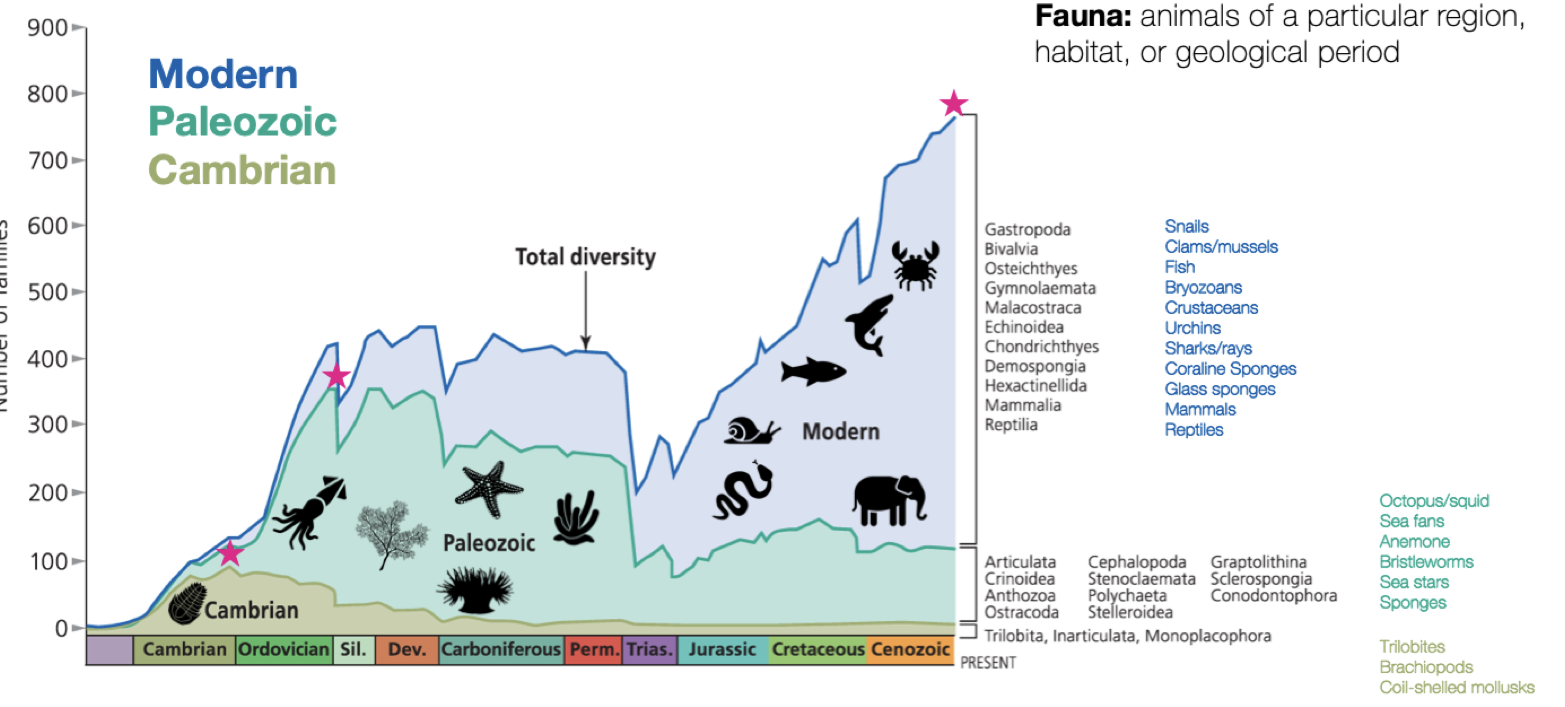 Adaptive radiation: when origination eclipses extinction. Can occur when populations evolve to occupy ecological niches in absences of competition. Involves exploitation of environments not occupied by competitors
Adaptive radiation: when origination eclipses extinction. Can occur when populations evolve to occupy ecological niches in absences of competition. Involves exploitation of environments not occupied by competitors
Organisms with new niches. When rate of new species is far greater than the amount going extinct. As they moved across new ecosystems of the different islands, they adapted. Ancestral branch lengths are long, not much happening - so many branched more recently.
Large-scale studies of fossils help chart the rise and fall of species assemblages. Researchers use genomic studies on macroevolutionary patterns in species that do not fossilize well.
Cambrian Explosion
Adaptive radiations: high rates of originations occuring in relatively short periods of time
Occurred long after animals began to diversify. During the Cambrian revolution, animals came and experienced and explosion of diversification. Lots of body patterns came out, animals evolved up to 800 million years ago. We are finding more evidence as time goes. Body planning - being even on both sides was huge for adaptation (bilateral symmetry appears). Animals were there, but stuff came that later preferred diversification.
Fossil records documented how animal Phyla emerged. Fill in the story a little bit more. We can learn about change, see things moving in different directions.
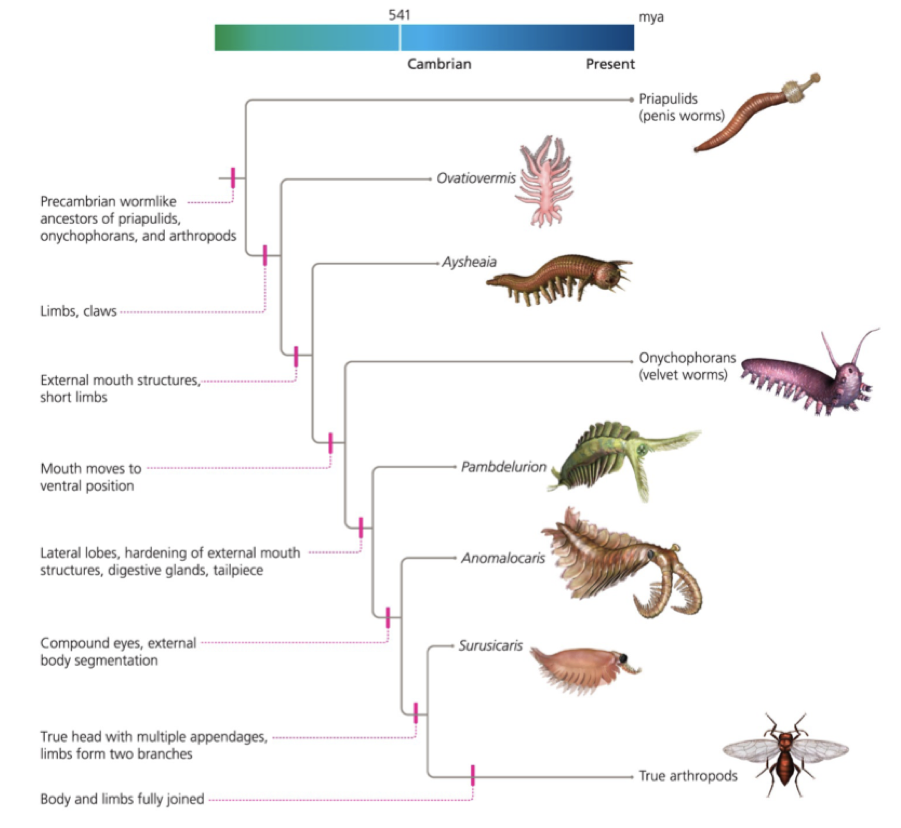
Extinction
Dinosaurs got the K-Pg asteroid, Dodo birds most likely died to us (food, and we introduced rats to eat their eggs, 1600s), Parakeets went extinct due to logging in the USA (too many trees cut down, early 1900s)
Background extinction rate: normal rate of extinction, rather predictable and steady rate.
Mass extinction: statistically significant beyond background.
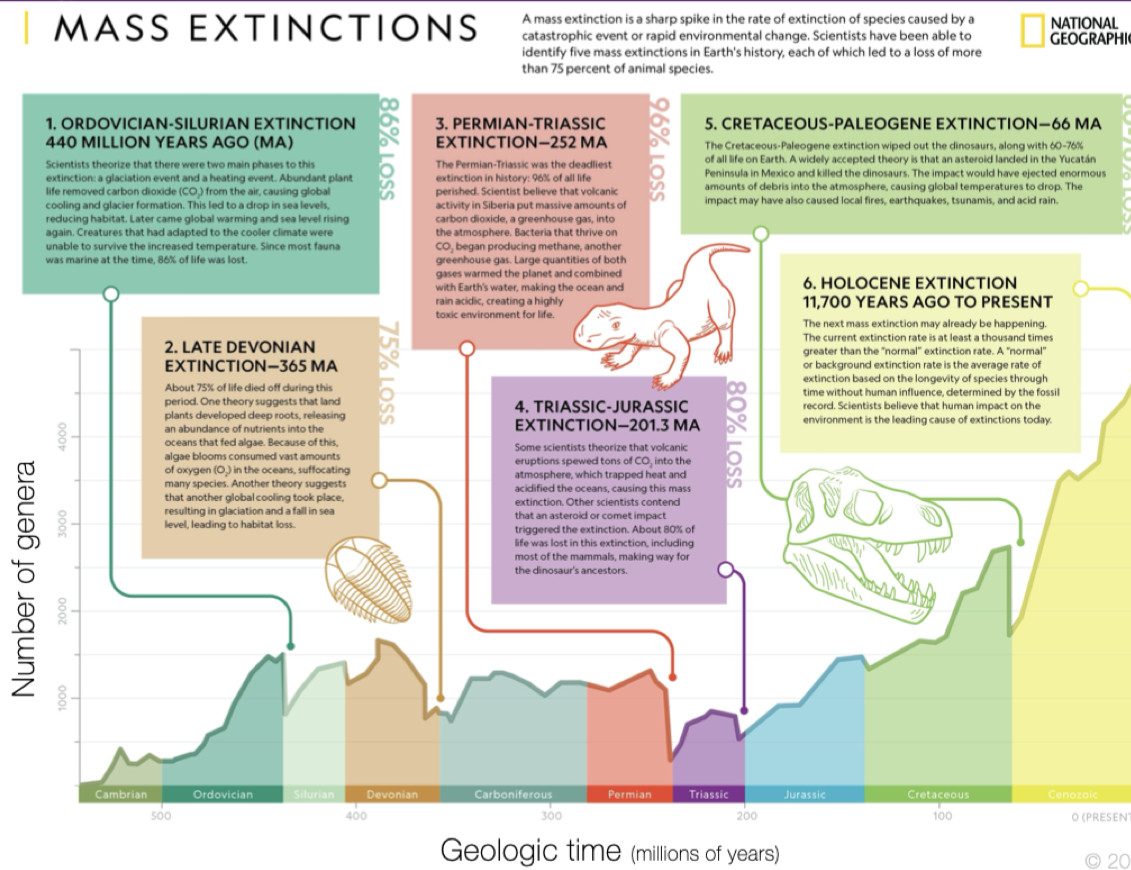 90% of things went extinct in the Permian-Triassic extinction. 5 is the asteroid. Massive drop followed by rapid increase is adaptive radiation.
90% of things went extinct in the Permian-Triassic extinction. 5 is the asteroid. Massive drop followed by rapid increase is adaptive radiation.
The niches that were taken up by dinosaurs, all new opportunities presented themselves for little mammals.
Permian extinction
60 000 years, in middle of a 500 000 year period of volcanic activity in Siberia. Great lava flows. Lead to anoxic conditions. Continued for so long, why so many organisms went extinct.
K-T extinction (K-Pg)
K-T boundary: not regularly found on earth. Not in thick layers. Common in meteorites and asteroids. Layer containing high levels of iridium, which suggests an ET impact 66 MYA. Thick layer shows things laster for awhile.
First day following the Asteroid, saw tsunamis, forest fires, particles reflected sun out, destroying the base of ecosystems (a lot of plants).
Impact off coast of Yucatan Peninsula. CO2 and SO2 in atmosphere (little O2 for respiration; ocean acidification). Dark dust cloud from explosion blanketed Earth for several years. No matter where, we have never found dinosaur fossils above the line. Dinosaurs are one part, because plants also saw a drastic impact to foundation of ecosystem.
Current mass extinction
Vertebrate extinctions over the past few centuries (since industrial revolution) has been majorly up.
Increase carbon dioxide is causing warmer temperatures. Coral reefs have seen ocean acidification for same carbon dioxide increase, which has in turn bleached the reefs.
Mass extinction can have cascading effects.
Coevolution
The reciprocal selection from species interactions may act directly on performance, but it is ultimately the evolution of these underlying components that shape the patterns of coevolutionary adaptation in performance.
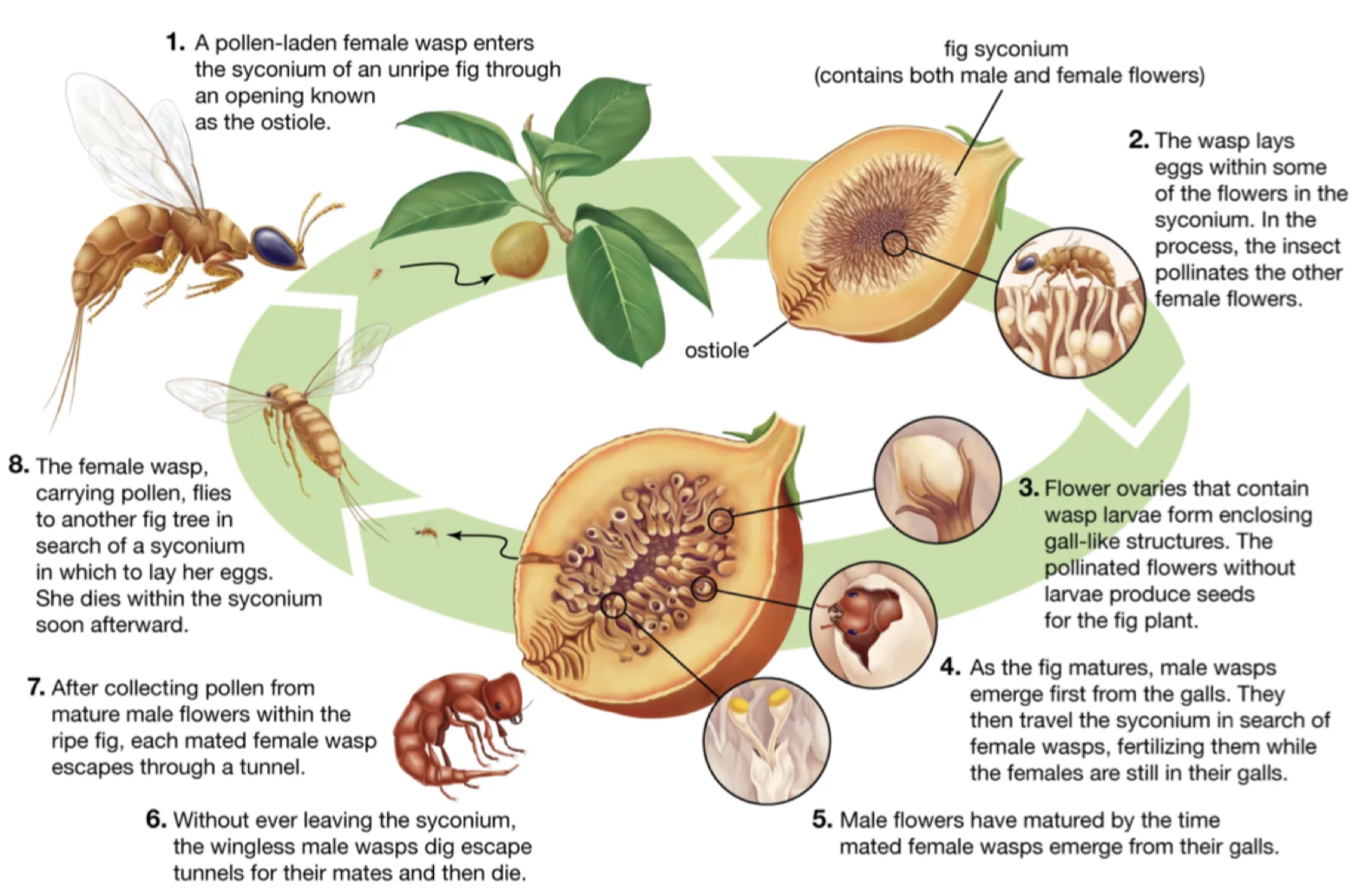 Fig wasp and figs are in an obligate relationship, meaning the nature of direct interactions. Fig wasps can enter the fig, go into flowers. If you’ve eaten a fig, you’ve likely eaten wasp larvae.
Fig wasp and figs are in an obligate relationship, meaning the nature of direct interactions. Fig wasps can enter the fig, go into flowers. If you’ve eaten a fig, you’ve likely eaten wasp larvae.
Coevolution: Reciprocal evolutionary change between interacting species driven by natural selection
Mutualism: positive/positive relationship between species that raise each other’s fitness
Pollination, seed dispersal, nutrient exchange between mycorrhizae and plants, farming, animals and microbiota, cleaning
Commensalism: positive/neutral relationship that benefits ones species but has a neutral effect on other species
Scavengers
Positive/negative: predator and prey, herbivore and plants, virus and host, deceptive pollination (flower tricks insect to coming to it, with no nectar)
Ants and Acacia
Bullhorn acacia - ants live on acacia tree and the ants benefit from home inside dried out thorns. Acacia provides specific food as nectarines, with the only biological function being for feeding ants. Fruity nubs for it to eat. Ants provide protection. With vs without ants graph shows the amount of herbivory, amount of foliage. Survival is better with ants.
Coevolution and Variation
Variation: parasitization success when wasps attack genetically identical aphids. Similar results using genetically identical wasps attacked genetically identical aphids. More aphids parasitized, more number of wasp families. Differed in resistance (encapsulation).
We need to show a genetic basis Looked at aphids, plant eating insects. They have sucking mouthparts to suck out the juice. Killing the aphid lets out a wasp. Aphids reproduce asexually - look within individual families, and a family represents a genotype. Frequency is the number of families, and number of aphids that are parasitized. Some are really good at avoiding wasps, while others suck - some variation in heritability, proxy for this.
A same bug can feed off a new species, and so there is a new niche for adaptation. Balloon vine has a lot of air inside, and it needs to travel mouth needle much further. Museum data of this specimen shows that before introduction of balloon vine (diet of only wooly rambutan/soapberry, they were small and we see and average beak length increase.
Geographic mosaic theory
Populations occur all over the place and are still the same species and same geographic region.
Populations in a geographic range experience different population experiences. Selection may be stronger or weaker on a species.
Cold-spot: at stasis (no change)
Hot-spot: intense selection
We see different levels of intensity, like a host super capable of avoiding parasitism, gene flow could be moving ready individuals to better area (coevolved alleles to adjacent populations).
 Coevolutionary alternation
Coevolutionary alternation
Can occur in interactions involving many species. When one species is in an antagonistic relationship with several species. Optimal species to go after is the smallest population, and then blue gets big, and then go after pink, pink gets big, go after green, green gets big, go after blue again. All populations are just getting bigger and bigger.
Cuckoos
Most host species effectively remove cuckoo eggs. Alternation example.
Brown eggs are intended to be laid by the Dunnocks bird and a cuckoo will dump a giant egg in their nest (blue). Baby cuckoo wants food from parent, and the Dunnock may die from exhaustion. Cuckoos don’t go for one host, and they normally get dealt with.
Coevolutionary arms race
Newt
Men went camping and drank toxins from a rough skinned newt - one newt has enough tetrodotoxin (TTX) to kill 200 herons and 2000 kingfishers, and 100 humans. Anti-predator posture. Colouration says don’t eat me.
Variation in toxicity: some newts have much higher amounts of toxins than other, and some have none and may be protected. We would think just enough would be the best because of resource allocation.
Trade-off: producing toxin is costly to reproduction, those not toxic don’t survive well but have many offspring, moderate means some survive and few offspring, and really toxic don’t get eaten but they have very very few offspring.
Evolution of toxicity occurred through coevolution with garter snakes. They never saw anything kill the newts except the garter snakes. TTX binds to sodium channels leading to fatal paralysis. Garter snakes evolved resistance to TTX through amino acid changes in the sodium channel. Little resistance has only a little bit of resisnce, all within one domain.
Trade off of life enters a balance. Geographic ranges show that wherever you have both species, the toxicity level and resistance levels are in the same tandem. Too much TTX resistance gives garter snakes lower crawling speed on average for some reason.
Rough-skinned newts have range of toxicity and garter snakes have range of resistance. Places of mismatch between the two - gene flow moving between.
Well matched - areas of intense selection. Evolving resistance requires a few amino acids to change, much harder to get to leading to mismatch populations with highly resistant snake and newts are not able to fight back.
Myxoma
In Australia, they ended up with 287 million rabbits. They introduced a virus which physically deformed them, although over time the rabbits bounced back. Everytime though, there would be a lower percent of rabbits that died from Myxoma. The lethality decreased.
Attenuated coevolution: if myxoma is too good at killing rabbits, it kills them before they can pass the virus on, and if its weak, the resistance will pull through. Less viral strains are favoured.
Mimicry
Mullerian mimicry: so many things have warning colouration and adaptation favour non-toxic species looking toxic/suspicious.
Heliconius butterflies
There are many different subspecies, although, morphological mapping is all the same. Different subspecies of each type. They are toxic to birds, with bright warning colouration. Local subspecies pairs coevolved. Diversified in tandem.
Parallel phylogenies. to the colouration pattern changing.
Introgression: movement of genetic material across species boundaries (hybridization)
Mutualistic species may exert positive frequency-dependent selection on each other, resulting in rapid coevolution. Mutualistic interactions are vulnerable to the invasion of cheaters, which can spread rapidly through a population.
Diversifying coevolution
you can accelerate divergence between population. Diversifying coevolution: increase in genetic diversity caused by heterogeneity of coevolutionary processes across range of ecological partners.
Coevolution and extinction → mainland flowers produce less fruit than island flowers. Due to local extinction of pollinators. Losing one will make you lose the other.
Highly specialized coevolutionary interactions make species dependent on each other. Extinction of one species may drive extinction of the other. Coevolutionary interactions can increase biodiversity. Genetic diversity diverges within geographic mosaic.
(Genes) Brains and Behaviour
Birds can learn to solve problems, use tools to increase water, get grubs, complex behaviours. Niko Tinbergen laid the foundation for studying behaviour.
Four questions
Proximate questions (How?)
How is it produced?
How does it develop?
Ultimate (why?)
Why do variations in behaviour influence fitness?
Why did it evolve?
Traditional approaches to behavioural genetics
Natural variant approach
Jerry Hirsch (1961). Inspired by artificial selection. Mutations occur naturally. More amenables to studies of ecology and evolution.
Flies are negatively geotactic - they will go against the grain. Hirsch put flies in a maze and if they went up he bred them, if he went down he bred them. None that went middle. He started selectively breeding. Small drop - relaxed selection for five generation and they began to move back towards center.
Greenspan checked for flies and selection on aggression.
Cap filled with fly food, introduced flies. They joust - can now give a food source, can fight, and are in a position where they can leave their babies. Selected group to be more aggressive - huge increase in aggression when selected for.
1960s would have stopped at heritability calculations, but now we all look at mapping differences.
Aggression has 700 genes associated with their level, some genes are hubs.
Single gene mutant approach
Seymour Benzer (1967). Inspired by success at dissecting development. Perhaps normal behaviour can be mutated. Caveat: do genes uncovered vary naturally?
Used to manipulate things in experiment. If we can mutanize bacteria, can we change behaviour? Blasted flies and checked circadian rhythms. Obviously genes influence behaviour, is there any variation in that gene?
Study circadian rhythms. Food, infrared light, cotton. Whenever beam blocks, the fly is awake. They check how many times the beam is crossed. With mutant fly - they saw a mutated sleep schedule.
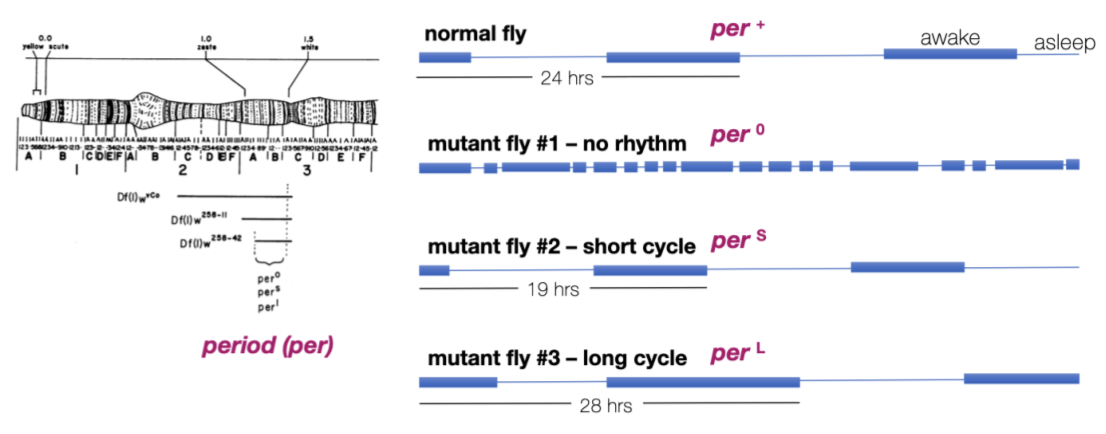 They did genetic crosses, and flies known to be missing chunks of chromosomes (found period gene), specifically the per gene, had an affected sleep cycle. There were three per alleles.
They did genetic crosses, and flies known to be missing chunks of chromosomes (found period gene), specifically the per gene, had an affected sleep cycle. There were three per alleles.
“per” exists in humans and mice.
ASPS: advanced sleep phase syndrome. Mutations in copy of period gene. Wake time is advanced.
Conservation of gene function on behaviour (eg. Hox genes): DNA sequence and gene function conserved across diverse lineages. Broad implications and applications. Genes affect all animals because of whatever.
2017 nobel prize: work on circadian clocks was recognized.
Foraging gene in honeybees
Foraging (for) gene in flies: Rover/sitter foraging polymorphism.
Honeybees: expression regulates transition from nurse to forager. Nurses go into cell, clean babies, take care of hive. Negative phototactic, staying away from exit.
Nurses: young adults, stay in hive, tend to larvae.
Foragers: older adults, leave hive, forage (pollen and nectar).
for expression naturally increases in adults turning from nurses to foragers. Manipulating colonies can increase nurses to foragers. Removing foragers makes nurses step up. you can also genetically increase expression.
Vocal learning in songbirds
Evolution of syrinx (voice box) and a dedicated neural system in zebra finches. Key gene for song is egr-1 (zenk). Many downstream genes.
Learning song is dedicated to this gene. Expressed a lot when hearing song for the first time.
Red path in the brain - motor output, produce sound from lungs.
Blue path: learning part, anterior loop, involve in song learning.
Canary has multiple different components to a cong, while cameroon indigobird has the ability to mimic a bird it is parasitizing.
egr-1 is an early gene. Encodes transcription factor (activated transiently and rapidly by bird song or act of singing). Can immediately suppress or enhance transcription of other genes. Expression is linked with familiarity → unheard song has a strong response, familiar song has little to no response. (activity shows dark pigmentation in brain).
Pair bonding in voles
Interspecific comparison. Voles differ in seduction of their partner. Meadow, comes in and bangs leaves. Done by vasopressin and receptor for it in the brain. The voles differ by their expression of the receptor.
High pair bonding: prairie vole
Solitary: meadow vole
Affiliation mediated by neuropeptide (vasopressin and oxytocin)
Expression of vasopressin receptor (V1aR) in brain.
V1aR brain levels and partner affiliation = feeding ventral pallidum or an agent used to derive V1aR expression in the VP. Expression occurs much less in brain region.
Allelic variation in V1aR in prairie voles. Longer insertion and shorter insertion is where the vary.
Courtship in Drosophila
Normal courtship: orientating → tapping → wing vibration → clicking → attempted copulation → copulation
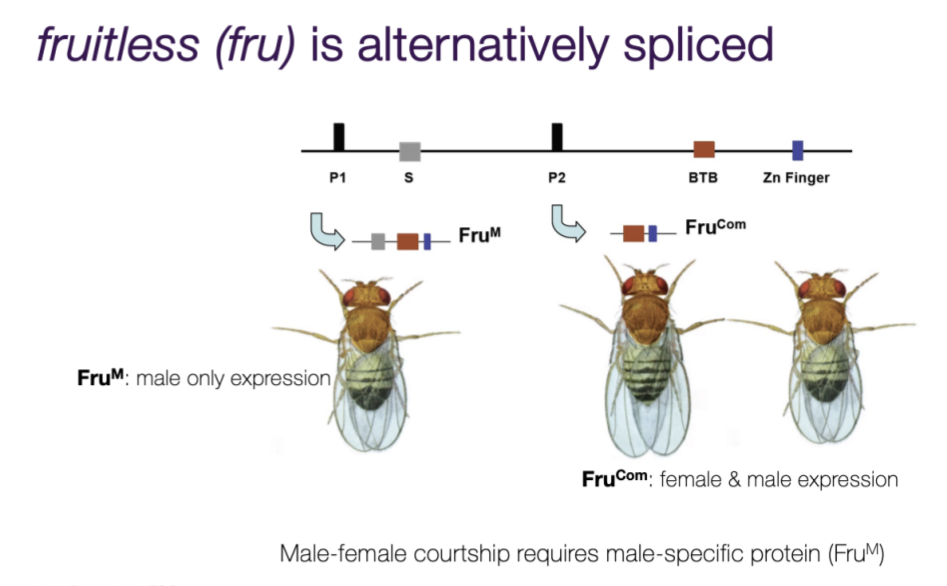 FruM includes 5 domain, only found in males. Important in male-female courtship.
FruM includes 5 domain, only found in males. Important in male-female courtship.
If you remove FruM, males will court each other. If we express FruM in female, will lead to female-female courtship.
Importance of fru: encodes transcription factor that is expressed in neurons of CNS (fly brain), FRUM expressed in olfactory neurons are critical for courtship function. FruM also necessary for development of male-specific neural circulation.
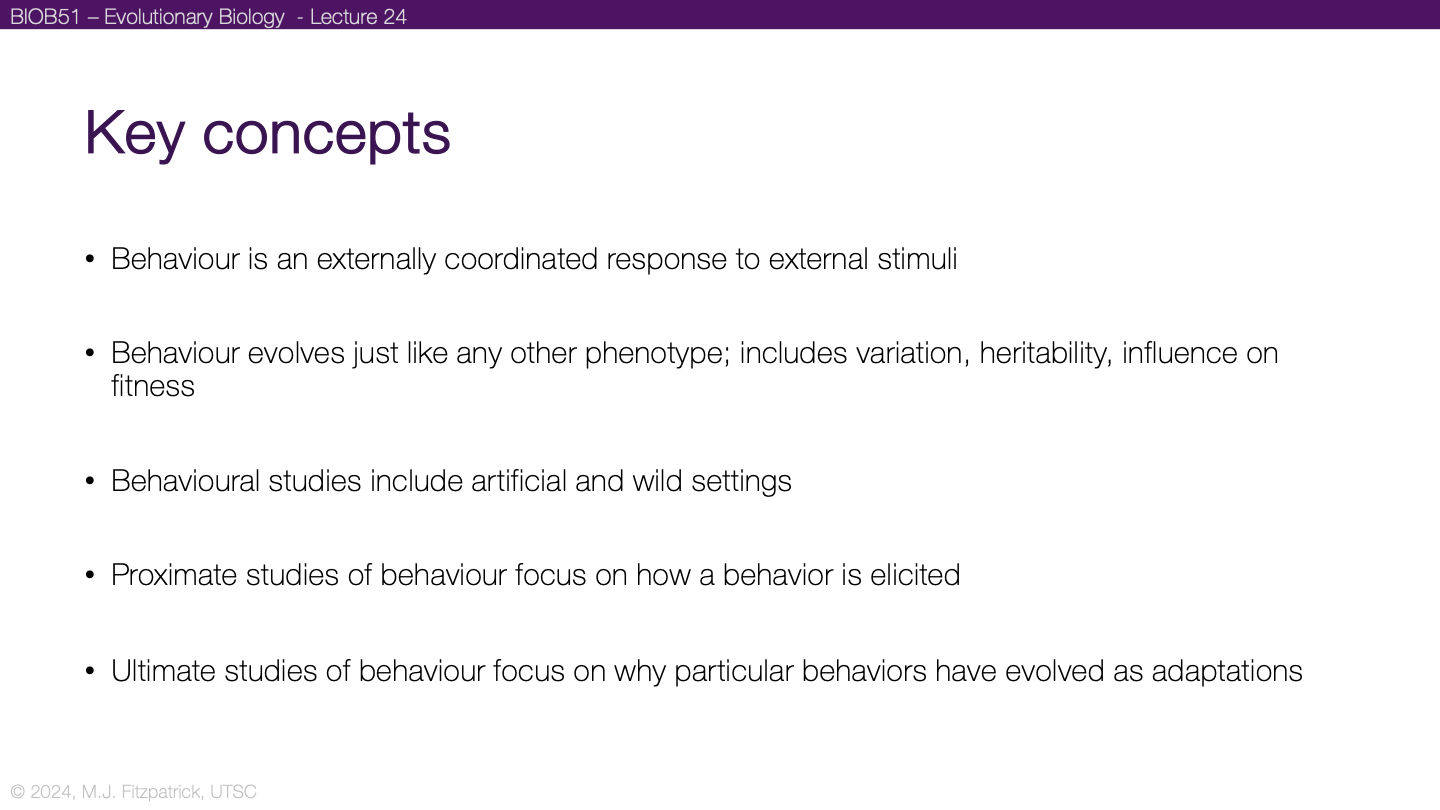 A11: Methods of Speciation
A11: Methods of Speciation
